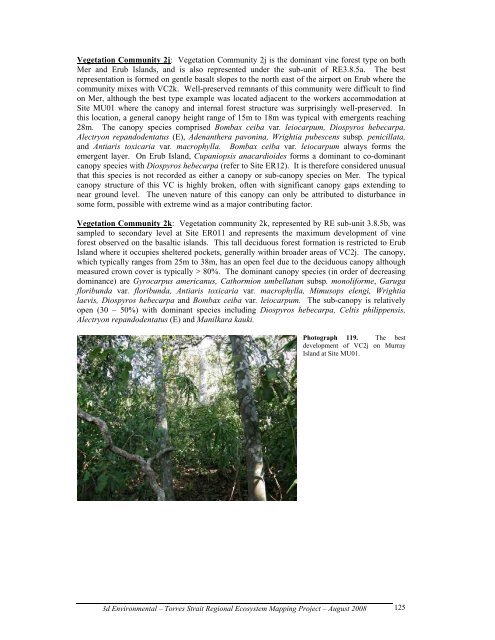Appendix 2 - Vegetation Communities and Regional Ecosystems
Appendix 2 - Vegetation Communities and Regional Ecosystems
Appendix 2 - Vegetation Communities and Regional Ecosystems
Create successful ePaper yourself
Turn your PDF publications into a flip-book with our unique Google optimized e-Paper software.
<strong>Vegetation</strong> Community 2j: <strong>Vegetation</strong> Community 2j is the dominant vine forest type on both<br />
Mer <strong>and</strong> Erub Isl<strong>and</strong>s, <strong>and</strong> is also represented under the sub-unit of RE3.8.5a. The best<br />
representation is formed on gentle basalt slopes to the north east of the airport on Erub where the<br />
community mixes with VC2k. Well-preserved remnants of this community were difficult to find<br />
on Mer, although the best type example was located adjacent to the workers accommodation at<br />
Site MU01 where the canopy <strong>and</strong> internal forest structure was surprisingly well-preserved. In<br />
this location, a general canopy height range of 15m to 18m was typical with emergents reaching<br />
28m. The canopy species comprised Bombax ceiba var. leiocarpum, Diospyros hebecarpa,<br />
Alectryon rep<strong>and</strong>odentatus (E), Adenanthera pavonina, Wrightia pubescens subsp. penicillata,<br />
<strong>and</strong> Antiaris toxicaria var. macrophylla. Bombax ceiba var. leiocarpum always forms the<br />
emergent layer. On Erub Isl<strong>and</strong>, Cupaniopsis anacardioides forms a dominant to co-dominant<br />
canopy species with Diospyros hebecarpa (refer to Site ER12). It is therefore considered unusual<br />
that this species is not recorded as either a canopy or sub-canopy species on Mer. The typical<br />
canopy structure of this VC is highly broken, often with significant canopy gaps extending to<br />
near ground level. The uneven nature of this canopy can only be attributed to disturbance in<br />
some form, possible with extreme wind as a major contributing factor.<br />
<strong>Vegetation</strong> Community 2k: <strong>Vegetation</strong> community 2k, represented by RE sub-unit 3.8.5b, was<br />
sampled to secondary level at Site ER011 <strong>and</strong> represents the maximum development of vine<br />
forest observed on the basaltic isl<strong>and</strong>s. This tall deciduous forest formation is restricted to Erub<br />
Isl<strong>and</strong> where it occupies sheltered pockets, generally within broader areas of VC2j. The canopy,<br />
which typically ranges from 25m to 38m, has an open feel due to the deciduous canopy although<br />
measured crown cover is typically > 80%. The dominant canopy species (in order of decreasing<br />
dominance) are Gyrocarpus americanus, Cathormion umbellatum subsp. monoliforme, Garuga<br />
floribunda var. floribunda, Antiaris toxicaria var. macrophylla, Mimusops elengi, Wrightia<br />
laevis, Diospyros hebecarpa <strong>and</strong> Bombax ceiba var. leiocarpum. The sub-canopy is relatively<br />
open (30 – 50%) with dominant species including Diospyros hebecarpa, Celtis philippensis,<br />
Alectryon rep<strong>and</strong>odentatus (E) <strong>and</strong> Manilkara kauki.<br />
Photograph 119. The best<br />
development of VC2j on Murray<br />
Isl<strong>and</strong> at Site MU01.<br />
3d Environmental – Torres Strait <strong>Regional</strong> Ecosystem Mapping Project – August 2008<br />
125


